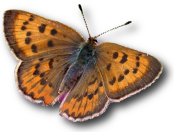 Art Shapiro's Butterfly Site
Art Shapiro's Butterfly Site
Monitoring butterfly populations across Central California for more than 35 years… Butterfly Collection Sites (Northern California)
- Castle Peak
-

Castle Peak
elevation: 2400-2775 m
number of species: 55
latitude: 39.33950
longitude: 120.34740
High Sierra. Subalpine and alpine vegetation; tree-line of Mountain Hemlock, Lodgepole Pine, Western Whitebark, and White Pine; persistent snow fields, boggy seeps, and wet meadows.
- Donner
-

Donner Pass
elevation: 2000-2200 m
number of species: 115
latitude: 39.32440
longitude: 120.38870
High Sierra. Montane communities with local subalpine elements; granite balds with herbs and low shrubs; mature Red Fir forest; large wet and dry meadow complex with a few boggy spots, fringing Willows and Mountain Alders.
- Gates Canyon
-

Gates Canyon
elevation: 190-600 m
number of species: 75
latitude: 38.38100
longitude: 122.03740
Inner Coast Range foothill canyon. Vegetation includes: Interior Live Oak woodland, Blue Oak woodland, Chaparral, Gray Pine, and riparian forest of Cottonwood, Bigleaf Maple, and Alder.
- Lang Crossing
-

Lang Crossing
elevation: 1500-1700 m
number of species: 80
latitude: 39.30410
longitude: 120.66870
West-slope Sierra Nevada. Mosaic of xerophytic vegetation (Goldencup Oak and Manzanita) and moist slopes with mixed mesic forest (including Douglas Fir, Ponderosa, and Sugar Pines); site also includes a large wet meadow with boggy areas.
- North Sacramento
-

North Sacramento
elevation: 8 m
number of species: 35
latitude: 38.56790
longitude: 121.42270
Central Valley Floor. Valley Oak woodland; riparian Cottonwood and Willow; annual grassland.
- Rancho Cordova
-

Rancho Cordova
elevation: 18 m
number of species: 35
latitude: 38.62410
longitude: 121.27770
Eastern edge of Central Valley. Interior Live Oak-Gray Pine woodland, Valley Oak-dominated riparian forest, and annual grassland.
- Sierra Valley
-

Sierra Valley
elevation: 1500 m
number of species: 65
latitude: 39.59490
longitude: 120.34930
East side of Sierra: Wet and dry meadows with Juniper-shrub steppe and irrigated alfalfa fields.
- Suisun Marsh
-

Suisun Marsh
elevation: 0-1 m
number of species: 50
latitude: 38.23750
longitude: 122.03860
Tidally-influenced complex of brackish and freshwater marsh. Plants include: halophytes, sedges, rushes, cattails, reeds, and herbaceous perennial composites.
- Washington
-

Washington
elevation: 850-1200 m
number of species: 55
latitude: 39.31660
longitude: 120.80990
Sierra Foothills. Deep canyon with mixed serpentine and metasedimentary geology. Canyon Live Oak woodland with mesic mixed lower-montane forest including Douglas Fir, Incense Cedar, and Ponderosa Pine.
- West Sacramento
-

West Sacramento
elevation: 9 m
number of species: 35
latitude: 38.58080
longitude: 121.57000
Central Valley Floor. Dense riparian Cottonwood and Willow forest with Valley Oak and Ash.
- Willow Slough
-

Willow Slough
elevation: 9 m
number of species: 35
latitude: 38.58080
longitude: 121.57000
Central Valley Floor. Dense riparian Cottonwood and Willow forest with Valley Oak and Ash.
Move your mouse pointer over the sites for a summary, and click on the site to for a full description.
Or choose from the list of sites below.
About these sites
The sites for this study are emphatically NOT randomly chosen. Nor are they meant to be "representative" of their ecological "communities," "biomes," or "life zones." They were chosen along an elevational gradient – the I-80 corridor – with an eye toward generating the maximum amount of data for comparison within sites among years and within years among sites. The criteria that went into their selection (in no particular order) were: ease of access; diversity of habitats within the framework of a manageable day hike; diversity of species present; low probability of major land-use change; and availability of long-term data from one or more nearby weather stations. The sites are not "pristine," though, as usual, the high-elevation one (Castle Peak) has the fewest visible human impacts. Several sites are unusually rich, faunistically speaking—they have significantly more species than one would be likely to encounter anywhere nearby—and this seems to be largely a function of disturbance. Very few California butterflies are adapted to, let alone restricted to, broad expanses of closed-canopy forest. A site like Donner, traversed by roads and the Transcontinental Railroad, presents a "permanent" state of succession highly attractive to butterflies. To the extent that they are relatively open, these sites may be warmer and have a better-developed and richer understory than "climax" sites. These are butterfly-friendly conditions.